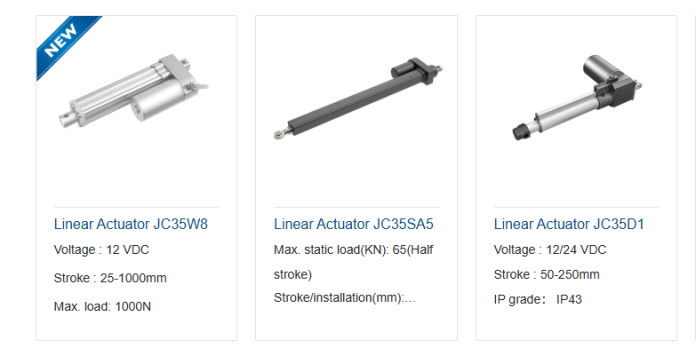A linear actuator is an essential component in various industries, offering precise motion control in applications where movement needs to occur along a straight line, as opposed to rotational motion. These devices convert energy into straight-line motion, making them invaluable in robotics, manufacturing, healthcare, and even home automation. Whether you’re new to linear actuators or are seeking to deepen your understanding, this article will cover everything from how they work to their diverse applications.
At its core, a linear actuator is a device that facilitates linear motion, typically by converting electrical, pneumatic, or hydraulic energy into a linear force. Linear actuators consist of a motor (electric, pneumatic, or hydraulic), a lead screw or gear, and a moving component that translates the rotational energy into straight-line movement. This motion is crucial in many machines and systems that need to perform tasks with precision and efficiency.
Types of Linear Actuators
1.Electric Linear Actuators
These are the most common type of actuators and operate using an electric motor. They’re ideal for applications that require controlled speed, accuracy, and reliability. Electric actuators are often used in healthcare, automation, and even furniture.
2.Pneumatic Linear Actuators
Pneumatic actuators use compressed air to generate motion. They’re fast, cost-effective, and easy to integrate into systems. However, they are typically better suited for environments where precise control is less critical.
3.Hydraulic Linear Actuators
Hydraulic actuators rely on fluid pressure to generate force, making them ideal for heavy-duty applications. These actuators are commonly used in industries like construction and manufacturing where substantial force and load capacity are required.
How Do Linear Actuators Work?
Linear actuators work by converting the rotational motion of a motor (or another energy source) into linear movement. In the case of electric actuators, when power is supplied to the motor, it turns a lead screw or nut, which drives a linear motion, moving the actuator’s rod back and forth.
In pneumatic and hydraulic systems, air or fluid pressure pushes a piston along a cylinder, producing the same linear motion.
Benefits of Using Linear Actuators
1.Precision and Control: Linear actuators provide highly accurate, repeatable motion, making them ideal for applications requiring tight tolerance and exact positioning.
2.Space Efficiency: These devices are compact and versatile, allowing them to be used in tight spaces or where other motion solutions may not be practical.
3.Customization: With adjustable speed, force, and travel distance, linear actuators can be customized to fit specific application needs, enhancing their versatility across various industries.
4.Durability: When properly maintained, linear actuators are highly durable and long-lasting, which reduces the need for frequent replacements and maintenance.
Key Considerations When Choosing a Linear Actuator
Load Capacity: Ensure the actuator can handle the weight or force required for the application.
Speed Requirements: Some applications require fast movements, while others need slow, controlled motion. Determine the speed needed for your system before selecting a linear actuator.
Stroke Length: The stroke length determines how far the actuator can move. Choose one that accommodates the required travel distance.
Environment: Consider the operating conditions, including temperature, humidity, and exposure to chemicals or water, which may influence the choice of actuator material and type.
Power Source: Electric actuators are often more energy-efficient, but in some cases, pneumatic or hydraulic actuators may be needed for heavy-duty tasks.
summary
The main advantage of linear actuators over other motion devices is their ability to provide consistent, controlled linear motion, ideal for applications that require high precision. At Linear Actuator Manufacturers, whether you are looking to increase automation in your factory, add comfort to furniture, or enhance medical equipment, there is a linear actuator solution to meet your needs. By understanding how these devices work and the different types available, you can make an informed decision to integrate the right linear actuator into your project.
If you are considering adding a linear actuator to your operation, be sure to evaluate your specific requirements for load capacity, speed, and stroke length. With the right actuator, you can significantly improve the performance and efficiency of your system.
For more information about linear actuator manufacturers, please visit our company website at https://www.jiecang.com/
FAQ:
1.What are the 3 most common actuators?
These are essential and can be found on nearly every automated machine. The three main types of actuators are pneumatic (air pressure), hydraulic (fluid pressure), and electric.
2.Why are linear actuators so expensive?
Linear actuators are advanced systems built with high-precision components and a durable design, making them ideal for heavy-duty applications. Their superior technology and engineering contribute to the higher cost, but they offer significant value.
3.What did linear actuators replace?
Electric actuators have slowly replaced hydraulic actuators in about 70% of applications — mostly for reasons related to cost, cycle life, and performance. Pneumatic actuators have been much harder to replace with other linear technologies — mostly because of their low upfront cost.
4.Is linear actuator better than pneumatic?
For example, pneumatic actuators can provide a higher speed, but electric linear actuators provide the most precise control since air and fluid pressure are more difficult to control than electricity.








